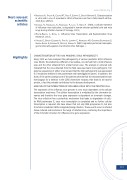Page 131 - MemoriaES-Eng
P. 131
www.ciberes.org
• r A, F A, c Mt, P F, g S, g-B B. Characterization
Most relevant odrígueZAlconueVASoZouerrAArcíAArreno
in vitro and in vivo of a pandemic H1N1 influenza virus from a fatal case.PLoS One.
scientific 2013;8(1):e53515.
articles
• AlFonSo, r., rodrígueZ, A., rodrígueZ, P., lutZ, t., nieto A . CHD6, a cellular repressor
of influenza virus replication, is degraded in human alveolar epithelial cells and mice
lungs during infection.Journal of Virology. 2013;.
• MArtín-Benito, J., ortin, J.. Influenza Virus Transcription and ReplicationAdv Virus
Research. 2013;.
• Y e, g-c A, F A, l c, k kP, g-e S,
ángüeZArcíAuleBrASrAuloMPArtnoBelocHutierreZrlAndSSon
gArcíA-SAStre A, eSteBAn M, nieto A, guerrA S. ISG15 regulates peritoneal macropha-
ges functionality against viral infection.Plos Pathogen.;.
Highlights
CHARACTERISATION OF THE H1N1 PANDEMIC VIRUS PATHOGENICITY.
Along 2013 we have analysed the pathogenicity of various pandemic H1N1 influenza
virus Straits. We studied two different virus isolates, one derived from a mild influenza
case and the other obtained from a fatal human case. The analysis in cultured cells
indicated that the virus obtained from the fatal case was clearly more pathogenic. Full
genome sequencing of either virus showed that the high pathogenicity was associated
to 3 mutations detected in the polymerase and haemagglutinin genes. In addition, the
study of the genetic background of the patients showed that the deceased patient was
homozygous for a deletion in the CCR5 chemokine receptor, that leads to an inactive
protein, a fact the probably contributed to the disease development.
ANALYSIS OF THE INTERACTIONS OF INFLUENZA VIRUS WITH THE INFECTED CELL.
The expression of the influenza virus genome is very much dependent on the cellular
transcription machinery. The cellular transcription is modulated by the chromatin dy-
namics and therefore the virus gene expression is dependent on chromatin changes.
The virus infection fires a proteolytic mechanism that leads to degradation of cellu-
lar RNA polymerase II, once virus transcription is completed and no further cellular
transcription is required. We have shown that not only RNA polymerase II, but also
chromatin remodeller CHD6 is degraded along infection. These events occur in infected
tissue cultured cells and also in the lungs of infected mice, reinforcing the importance
of the chromatin structure for influenza virus gene expression.
13
20
T
OR
P
RE
L
A
NU
N
A
S /
E
ER
B
CI
131


